
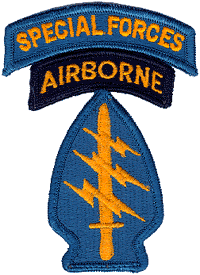
LeapFEST 2000 using CH-47D Chinook helicopters!
Official LeapFest RIARNG web site
THE FORT BRAGG POST
By Paratrooper Mike Sparks
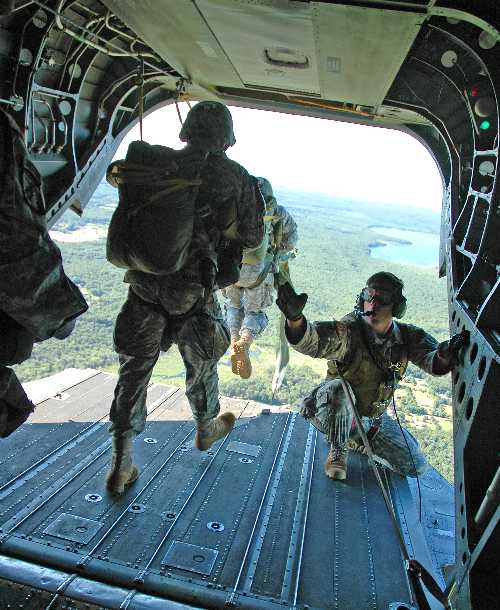
Nine ominous-looking, olive-drab clad UH-1H "Huey" helicopters in a row parked under a blazing sun on a grass field; wire cutters and antennas bristling; each with 4 Paratroopers "sitting in the door" with orange jumper ID tapes on their woodland camouflage PASGT Kevlar helmets, a jumpmaster, crew chief and two helmeted pilots with tinted visors down as the rotors turn to full power. One by one, they hover 3 feet off the ground, engines at full throttle, heat waves emanating from their upturned infared deflecting exhaust pipes, then "back-up" and turn for a take-off run at about 12 feet as the school buildings whiz by to achieve maximum lift.
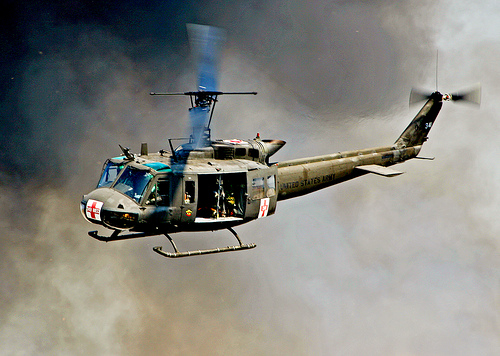
Click here to learn how to fly a Huey!
On order, you pass the waist safety belt forward as the pilot and jumpmaster jockey the bird at 1,500 feet against strong head winds to reach the personnel release point- "One minute!" ...The jumpmaster spots the "H" made of orange VS-17 panels laid on the ground and begins his count to place us well upwind and able to reach-not under or overshoot the drop zone. You are anxious because you yourself cannot see the drop zone (DZ) the offset is so far off, but you know that you are going northeast into the wind and it will be to your left rear after you exit and gain canopy control. He taps the shoulder of jumpers, 1 and 2, then myself: "Go!" I'm gone before I can hear him tap #4 out.

Welcome to LeapFest '95!
This very well organized International Military Parachuting competition put on by the Rhode Island U.S. Army and Air National Guard centers on 4 man jump teams steering MC-1-1C parachutes to a pie plate marked/surrounded by an "X" on a plowed farmer's field drop zone (DZ) donated graciously by the Shardtner family. Judges time every paratrooper from parachute landing fall (PLF) to the "frisbee"; the team with the least time cumulative wins. Theoretically its possible to have a team time of "zero" if everyone hits the "frisbee" from the air. For Fort Bragg-area Paratroopers it begins with efficient C-130H pick-up/return, from Quonset Air Base with its huge Navy SeaBee statue with 6 arms holding wrench, submachine gun, hammer and "the kitchen sink", then to the beautiful University of Rhode Island accomodations, excellent dining facility; fruit drinks, orange juice, soda pop, milk, coffee, tea, on tap, all-you can eat salad bar with tuna salad, fresh white/whole wheat rolls, stir fry vegetables, baked cod or chicken, mashed potatoes, gravy and fresh apple pie. Manifesting for 76 teams was done by computer in seconds; after a brief meeting with LeapFest officials, team leaders had directions to the dorm sleeping rooms, tickets for chow and Saturday's banquet in hand. There was no "Hurry Up and Wait" often associated with U.S. Army functions. Allied nations from Germany, Great Britain, Tunisia and Canada brought teams. This is the best time to buy your official LeapFest t-shirt since you'll be too busy the next day "being there and doing that " to buy your t-shirt.
The Pick-up zone (PZ) and jump
We bus to a school field, along the way an Alaskan 1-501st PIR paratrooper tells of a buddy who was coming down on top of a moose who didn't pay attention to his screams to move. The other jump buddy replied that an old man had gotten killed recently by a Moose that ran him down. He said that his jump buddy landed on and killed a deer. They debated whether the video footage of the "Moose landing" or "Deer strike" would be suitable for America's Favorite home videos T.V. show. He then told of his time with the 1st SFG (ABN) in South Korea on a "peacetime" training exercise with their militia. Playing the part of North Korean aggressors, a SCUBA team got killed by a South Korean militia .50 caliber heavy machine gun team when the latter forgot that it was just training...or so he said.... At the PZ, each team drew main parachutes/reserves from semi-trailers supplied by 19th SFG (ABN) Utah ANG. The British jumper's kevlar helmets are dome shaped with 3 point suspension chin strap and about 1/2 pound lighter than ours, I learned that back in their country, they are jumping at 500 feet now with their new Irvin 5200 Low-Level Parachute parachute with has a small drogue chute to speed deployment of their super-large main. I also discovered that the German Fallschirmjaegers are heavy-dropping their 3-ton Wiesel mini-APC, which can mount TOW II ATGMs, 20mm cannon or 4 troops in the back. Old friends meet, girlfriends looking for old jump boyfriends. Boy meets paratrooper girl. Alaskan LRSUs (Long Range Surveillance Units) with white arctic camouflage covers for their Kevlar helmets, patches from Airborne units all over the U.S.; often with "Airborne" tabs over Divisional patches usually associated with so-called "leg" units.
It was great to see the old Huey turbine up in mass formation, its sheer power and "distinctive 'WHAP, WHAP' of its rotor blades echoing throughout the field. As the formation of 10 Hueys flew in (One was for a MEDEVAC) a witty paratrooper saw their resemblance to the movie, Forest Gump's opening scene from Vietnam; so he said; "My name is Gump. Forrest Gump." I told him I was "Bubba" and I wanted to know if he liked "shrimp?"

After donning our MC-1-1C 'chutes and reserves we passed muster of a vigorous JMPI (JumpMaster Personnel Inspection) by our final team-mate, a Military Intelligence Captain from the 313th MI BN. Without a doubt, JMPI is best done by 82d ABN JMs; they know a diagonal backstrap "tuck" that is fantastic at eliminating opening parachute shock as one example.
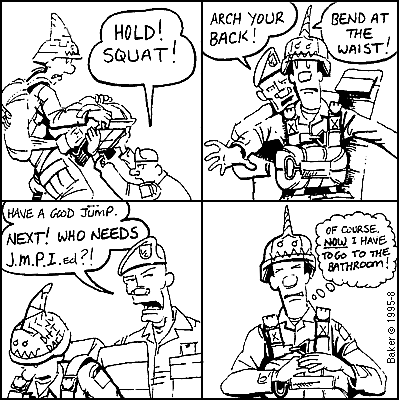
We were at the end of the first group and benefited from better jump spots after some of the first jumpers landed in the trees. As the day wore on, the time delay after flying over the "H" ground panel increased from 20, to 25, then 35 and 45 seconds in order to counter-act gusting and unpredictable strong winds. Fortunately the MC-1-1C has a 7 mph drive that can be used to fly against strong winds if the paratrooper is careful and makes sound, safe control decisions. We would end jumping twice for time instead of 3 times due to the delays caused by strong winds.
We sat in the "birds" and were "hooked up" by the jumpmaster. As #3 jumper I snapped in the safety belt and we were soon climbing high into the air. The 60-knot wind blows your legs hard and you lean back on your hands to avoid sliding out; there is nothing to hold onto; the Huey has been taped flush of all sharp edges with seats removed. The landing skid is actually far under our legs; you'd really have to exit weak deliberately to get caught on it, I doubt it even then. Below us we can clearly see other Huey's rotors spinning like a strobe light, on the ground picking up jumpers, some racing by after just dropping jumpers off, and still others ahead in the distance dropping men and 'chutes in an awesome spectacle. After "sounding off for equipment check", the moment fast approaches; "GO!!!!!" I push off and out with my palms on the floor and snap into a tight body position; the sky is an eerie blue: I can see the scenery below but no helicopter: I am committed. As I fall and count in thousands, I press my body tighter to insure clean opening and feel weightless. Before my 6-second count is up, 4 nylon risers appear and I look up to see a beautiful canopy with H-TC opening in the rear.
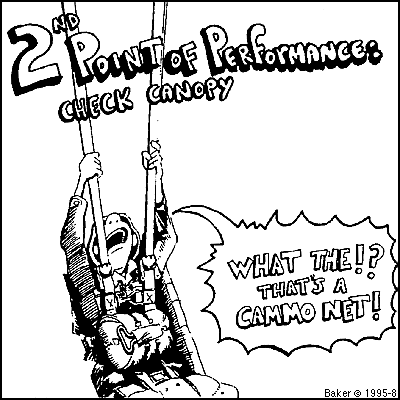
I reach up and grab the toggles and look over my left shoulder; the orange "X" and a lot of smoke blowing very fast. I must turn right and face into the wind since I'm being blown sideways. A gust of wind blows and I oscillate. Its taking longer to turn into the wind than I like. I look down below; still over houses, trees and power lines. Not good. Still have altitude. Crowd below in the distance. Its beautiful and fascinating up here; I 'm where eagles fly. My teammates are close. One turns towards me from above; I call out to him to watch it. We turn away and are both holding into the wind. I adjust right to keep holding, he runs and zooms away to my left; he'll probably overshoot. I'm getting low and still not over the plowed DZ, so I turn to run. I get over the "X" but am still 100-200 above.
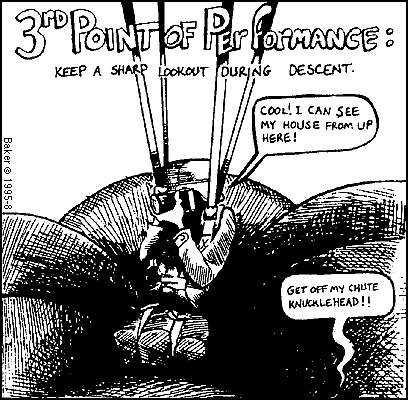
I am disappointed, I'll overshoot also.. Another gust of wind! I turn into the wind and can see that I'm being blown back and to my left...a left rear PLF...yucck...my least preferred direction. I turn my feet and twist my body with toggles level at my forehead in anticipation..I look out and see the horizon..ROLL! The ground comes up and whacks my backside; I jump up and release my cable-loop release to release my right riser and collapse my canopy...the clock has started!
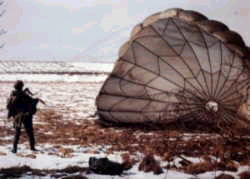
The landing from the no-porosity-fabric "Dash-1 Charlie" is pretty soft compared to the MC-1-1B we jumped for Operation Dark Claw, our demonstration of folding All-Terrain "Mountain" Bicycles. I grab as much canopy as I can and begin running to the orange t-shirted judges by the "X". My throat goes dry as I failed to practice the hydration I preach enough. The field is soft and dusty; your boots sink in half a foot and each running step is a test of willpower. The crowds hollers for me to keep running. I make it in 3 minutes 13 seconds.
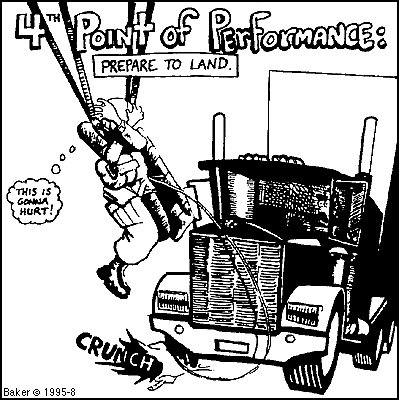
The Drop Zone: outrageous!
After catching my breath and downing some H20 on sale, I take my parachute now inside my kit bag to the nearby shake-out station then turn it in with my team, keeping my reserve for the next jump. Waiting for the bus back to the PZ, I survey the LeapFest panorama: Paratroopers hitting the "X" or very near and running with all their might, others hitting homes, landing in trees, snagged on wire, on the roof of the Shardtner's Farms green house (though seconds later, a "green glob" sprints by with tangle of parachute in hand to reach the "X"), one jumper landing on the static display OH-6 Cayuse "Little Bird" helicopter , others hitting the pavement, or landing in the crowd of assembled spectators, some lounging in patio chairs! ....certainly the fact that this is the 13th annual LeapFest has nothing to do with this! All around me are hundreds of people; there is a shaved ice lemonade stand, young college-age girls from the American Legion selling t-shirts with a paratrooper in full-scale "toggle-line" panic, fine-looking women in sun dresses and floppy hats holding the hands of their children or wearing sun glasses and just looking sexy, Hot Dog and food stands with bleachers, Rhode Island National Guard recruiters handing out pencils and superb posters of a paratrooper coming down as dozens of REAL PARATROOPERS in the same pose were swooping down from the sky above all around. A Swedish Haaglunds BV 202 over-snow/water tracked vehicle trailer from the C Company, 3/172d Infantry, Vermont NG Mountain unit is on display which I inspect closely for operational insights. Its a Hagglunds BV-202 called a SUSV reminds me of the astronaut rover from the old "Lost in Space" T.V. show.

The Banquet: Lobster and Steak at the American Legion Hall
After 2 jumps, the best scores were determined; we went to the local American Legion Hall and enjoyed a cup of Rhode Island-style clam chowder as an outdoor cook-out took place. Called inside the building, the best team time was Co G, 143d LRSU from Texas with a time of just 600 seconds-8 jumps from 4 people-or about a minute or less for each jump. 2d place was Ft. Bragg's Special Operations Training Branch who only came forward reluctantly since "they really were not there" though they were the only ones wearing olive drab flight suits other than the helicopter crews! 3d place was the 134th LRSU from Nebraska. After that it was huge lobsters or a chunk of steak grilled to your satisfaction, followed by dancing by a Dee-Jay to the "wee hours of the morning".
LeapFest: the conclusion
LeapFest '95 was an outstanding success, it challenged every paratrooper to hit the "X" which many did or failing that to hit close to the DZ and land safely. The injuries sustained were mostly minor though one 21-year old Paratrooper, PFC. Frank Ciliberto of the 18th Field Artillery Brigade's Headquarters and Headquarters Battery had serious head and lower body injuries that keep him in the intensive care unit at Rhode Island Hospital [See UPDATE 2001 below] and another, 1LT Roy Banzon an Assistant S-4 with the 16th MP Brigade (ABN) with 51 jumps broke his leg/ ankle when he landed on a house. according to Captain Chris Callahan, RIANG PAO and AP Wire reports. I saw a Paratrooper on the ground with an injured shoulder, who could have been the young Specialist I interviewed later on at the banquet who had his arm in a sling for a shoulder dislocation! Paratroopers are tough and mend on the quick. The article in The Providence Sunday Journal was far too negative and didn't publish any pictures which shows a lack of interest in the Airborne mission unless some exploitive bad news is associated. True, better winds would have prevented these injuries, but even still there are some steps that we can do for future Airborne operations with steerable round parachutes (and all parachuting) to prevent obstacle landings and failing that to walk away uninjured.
Better jump spots from jumpmasters
Most jumpmasters have never actually thrown a streamer to determine winds and release points for a personnel jump. (Wind Streamer Vector Count). WSVC is more accurate than just a ground mark since the streamer falls from actual jump altitude to the ground; winds can differ along the way. If teams continue to report in early Friday, their JMs need to go to the PZ and fly with a Jumpmaster experienced with this technique and get a chance to practice. This will also familiarize themselves with the area from the sky and the then current wind conditions. Another possibility would be to have LeapFest provide the jumpmasters for every team since they would be ahead of the "learning curve" having done this before many times. We asked for and got a LeapFest Jumpmaster to actually spot and signal us when to jump and he was outstanding; all of his teams landed safely in the drop zone despite our own miscues/handling decisions. A good jump release spot can greatly improve the chances for hitting the "X" and hitting the DZ even despite bad canopy handling.
Improve parachute maneuvering skills
XVIII Airborne Corps paratroopers generally are more experienced with the non-gliding T-10C parachute than the steerable MC-1-1C. Most of the injured and rough landings were from the "All-Americans" of the 82d Airborne Division who specialize in mass tactical jumps with the T-10C or supporting units in the Airborne Contingency Corps who jump in with the same non-steerable 'chute. The MC-1-1C is a gliding canopy with a 7 mph forward speed; it takes piloting to arrive at a safe landing. You must determine wind direction, then judge wind speed and come up with plan for reaching the DZ. I hope my personal account above gives you an idea of the thought processes involved. You need to stay upwind as long as possible since in a wind stronger than 7 mph, once you are downwind you cannot get back. Paratroopers must judge altitude/time left as well as real speed over the ground. If I hold into the wind do I have enough altitude to give me enough time to be blown back into the DZ? If not, when do I stop running? Regardless, at 150 feet all jumpers should hold into the wind to prepare for landing to negate the 7 mph forward speed of the MC-1-1C for a soft landing. I saw many Paratroopers run with the wind-while you can get away with it with a good PLF on soft plowed fields, you are not likely to be uninjured if you hit something hard and fail to PLF properly with legs, feet together. Pulling down on both toggles will brake the parachute and cause it to descend rapidly which is dangerous below 200 feet. Pulling down quickly and releasing and not gradually will cause the canopy to oscillate. The standard pre-jump training narrative fails to describe the gliding nature of the MC-1-1C and should be amended. The MC-1-1C is more than its appearance as "a T-10C with holes cut out and steering lines".
We should highly encourage jumpers to take notes during Friday night's mission brief; especially a DZ schematic for mental preparation for the next day's jumps. Writing things down makes the jumper internalize the information for better memory and understanding. At the PZ a large schematic drawing with wind arrow for piloting visualization should be on display covered by clear plastic for up-to-date changes on wind direction/severity. Teams could view this before boarding their aircraft for their jumps; even a sandtable of the terrain below would help. General James M. Gavin said the "sand table was the secret weapon of the 82d Airborne Division in WWII". Faster orientation after canopy check will yield less altitude and upwind advantage lost trying to find the "X" and/or executing a glide plan.
A Steerable round Canopy computer flight simulator from the U.S. Forest Service for practice friday night could be obtained to shrink the "leaning curve" by allowing Paratroopers to practice parachute maneuvering skills and see safely what poor canopy handling could do. POC: David Pierce USFS, Missoula, Montana or Systems Technology Inc. 1367 Hawthorne Blvd., Hawthorne, Ca. 90250 (213) 679-2281 POC: Mr. Jeff Hogue. U.S. Special Operations Command at MacDill AFB in Florida is reported to have one such system. It was the 1st TSG (A) that contacted STI in 1990 and suggested that students hang from a suspended parachute harness for better realism than sitting in a chair. [Editor's note: President George Bush used this simulator to get ready for his epic freefall jump in 1997]
Misinformation like what one Paratrooper told me; "the Canopy will face itself into wind if you leave the toggles alone"; must be corrected prior to jumping, the MC-1-1C is not a T-10C non-steerable; if the toggles are left alone the wind will blow into and spin the canopy until the H-TC orifice is reached, then it will blow through this path of least resistance and RUN the canopy and Paratrooper WITH THE WIND; a gliding canopy is not a neutral descending canopy, it will only face into the wind if you turn it and keep it there.
Explain "why" on emergency procedures Paratroopers need to know the reason why you do not try to lower yourself if you snag on power lines. As I ran towards the paratrooper hung by the powerlines, I saw pardon the pun, "sparks flying". I called out for the power to be shut off and to not touch him or to try to get down which would create the ground needed to shock him. . A friend of the neighbor whose house was nearby had a knife in hand before MPs stopped him. All of the Paratroopers present should have known to stop him. The lady shut her power down and the canopy was held then raised so the Paratrooper was low enough to cut-away from his harness to the ground. We need to explain WHY procedures are done so they will be remembered by reasoning, not just rote memorization. Understanding the problem will "clue you in on" the solution if you forget the proper phrases of a solution. The current Airborne procedure manuals do not do this enough, nor is it stressed adequately in training.
Improved equipment
Had soon to be type-classified with National Sock Number (NSN) Parachute Jump Braces made by the nearby AirCast Company of Summit, New Jersey been widely issued and used we could probably have prevented the broken ankle injury and other non-reported minor sprains. Helmet head shock pads conceived by the 1st Tactical Studies Group (Airborne) are now an issue item that can be slipped up inside the PASGT kevlar helmet for hard landing protection. Elbow/knee pads cut from unused portions of closed-cell foam sleeping mats can be slipped into the back side of the BDU knee/elbow reinforcements to give padding for hard landings.
The soon-to-be developed T-10D or "T-21" military static-line parachute should have its reserve on the back packtray with the main parachute which simplifies and speeds JMPI and logistics; no need to keep a separate reserve throughout a day's jumping or lose track of it as you wait in the PZ; its built-into the main and "present for duty" at all times. A reserve integral to the main would facilitate faster running on the DZ; just release both legs straps to free your legs. Every U.S. military Paratrooper needs to write-in to the Parachute Engineering Branch at U.S. Army Natick Labs at Natick, Massachusetts 01760 to insure the new parachute is designed correctly from the beginning.
Ask for feedback from participants
A Confidential critique/questionnaire could be handed out Sunday before departure so participants can give positive feedback and express thanks for the outstanding job done by the LeapFest organizers, but not a formal in-person After Action Review. LeapFest should remain fun so as to insure popular participation using discreet troop feedback without becoming bogged down as yet another official training exercise full of bluster and posturing, but making steady progress to improve the Airborne operation.
AIRBORNE!
FEEDBACK!
I was reading Chronicles of a leapfest '95 jumper and it is all wrong I am the older brother of PFC Frank Ciliberto of the 18th field artillery brigade's headquarters. I was personally witnessed the juspfest with my family and friends. This story is sadly wrong and needs to be corrected. This is what it said on the page:
"Word has it that "the Paratrooper with the head injury" in the hospital felt well enough to attend the banquet and tried to walk out, but was told to stay put!"
(AES Editor: we corrected this statement]
The true story should read that he was hospitalized for a few years and during the banquet he was going though brain surgery at the Rhode Island hospital for about 12 hours. General Centrochio of the Rhode Island National Guard sat in the waiting room with my family and friends awaiting my brother to come out of surgery. In no way was he able to go to a Lobster Banquet that was stated in the report posted. To this day he still needs medical attention.
We know that the helmet stayed on his head and it was crushed in but we don't remember the chin strap. besides the cracking his skull he also broke all the bones in his face and jaw. He came down right on his head.
Thanks,
David Ciliberto
www.cilibertoswoodworking.com
cilibert@together.net
OUR REPLY: Its long overdue that the U.S. Army Paratrooper get a new helmet with foam padding inside to absorb a hard landing with a decent chinstrap that will not fail and result in the helmet falling off.
 Return to U.S. Army Airborne Equipment Shop
Return to U.S. Army Airborne Equipment Shop